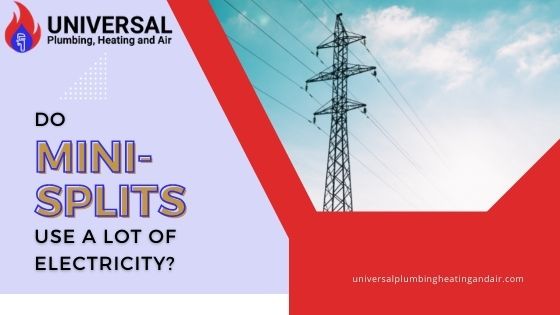do mini splits use a lot of electricity
Mini-split air conditioning systems have gained popularity in recent years due to their efficiency and flexibility. If you are considering installing a mini-split AC unit, you may be wondering if it uses a lot of electricity. This article will shed light on the energy consumption of mini-split systems, the associated costs, and more.
Understanding Mini-Split Energy Consumption

Mini-split AC units are known for their energy-efficient performance. They function similarly to traditional central air conditioning systems but offer individual cooling zones, allowing you to customize comfort levels throughout your home or office.
One major advantage of mini-split systems is their inverter technology, which allows them to adjust their compressor speed according to the cooling demand. Unlike conventional AC systems that frequently cycle on and off, mini-splits operate more consistently at lower speeds, optimizing energy consumption.
Thanks to this technology, mini-split AC units consume significantly less electricity compared to traditional systems. Their ability to precisely control the cooling output for each specific area translates into lower energy usage, resulting in potential savings on your monthly utility bills.
Factors Affecting Mini-Split Energy Consumption
Several factors can influence the energy consumption of a mini-split system, and it's important to consider them when assessing its efficiency.
Size and Capacity of the Unit
The cooling capacity of a mini-split AC unit is measured in British Thermal Units (BTUs). The size of your space and the number of cooling zones you require will determine the capacity you need. Choosing a properly sized unit will ensure optimal energy efficiency as it matches your comfort needs without overworking the system.
Insulation and Air Leakage
Proper insulation and sealing of your home or building play a significant role in minimizing energy waste. Good insulation helps maintain a consistent temperature, reducing the workload and energy consumption of the mini-split system. Additionally, sealing any air leaks in windows, doors, or ductwork prevents cool air from escaping and warm air from entering, further enhancing energy efficiency.
Usage Patterns and Programmable Thermostats
Your usage patterns and the settings you choose on your mini-split system can affect electricity usage. Programmable thermostats allow you to set temperature schedules and adjust cooling levels according to occupancy and time of day. Utilizing these features wisely can help optimize energy consumption.
Calculating Mini-Split Electricity Consumption
If you're curious about the exact energy consumption of a mini-split system, it's essential to understand the units of measurement used.
EER and SEER Ratings
Energy Efficiency Ratio (EER) and Seasonal Energy Efficiency Ratio (SEER) are two commonly used metrics. EER measures the cooling capacity of an air conditioner relative to its power consumption, while SEER represents the cooling output over a typical cooling season divided by the total electrical energy input during the same period. Both ratings provide an indication of how efficiently the unit uses electricity.
For example, a unit with a higher SEER or EER rating will consume less electricity to produce the same cooling output as a unit with a lower rating.
The Cost of Mini-Split Electricity Consumption
When assessing the cost of electricity consumed by a mini-split system, it's important to consider both the energy usage and the electricity rate provided by your utility company.
By multiplying the unit's power consumption (measured in watts) by the rate of electricity (measured in kilowatt-hours) charged by your utility company, you can determine the cost of running your mini-split system. This cost will vary depending on your location and the prevailing electricity rates. To get a precise estimate, you can consult your utility provider or refer to your electricity bill.
Savings and Return on Investment
While mini-split systems may be initially more expensive to purchase and install compared to traditional AC systems, their energy efficiency can result in long-term savings.
By reducing your monthly energy consumption, mini-split systems can help lower your utility bills, potentially offsetting the higher upfront costs over time. Additionally, as technology continues to advance, the cost of mini-split systems is gradually decreasing, making them a more affordable option for consumers.
Considering Other Factors
While energy consumption is an important consideration, it's also crucial to evaluate other factors when deciding on a cooling system.
Mini-split systems offer benefits beyond energy savings, including:
- Flexible installation options
- Zoned cooling capabilities
- Quiet operation
- Improved indoor air quality
These additional advantages contribute to the growing popularity of mini-split systems in both residential and commercial settings.
Conclusion
Mini-split AC units offer energy-efficient cooling solutions for homes and businesses. Their ability to precisely control cooling output, inverter technology, and zoned capabilities contribute to their lower energy consumption compared to traditional systems. By taking into account factors such as unit size, insulation, usage patterns, and programmable thermostats, you can further optimize energy efficiency. The electricity consumption and associated costs of a mini-split system can be calculated using EER/SEER ratings and your local utility rates. While mini-split systems may have higher upfront costs, their long-term energy savings can provide a return on investment. Considering both energy efficiency and other benefits such as installation flexibility and zoned cooling, mini-split AC units are an attractive option for those seeking comfort, convenience, and cost savings.


Post a Comment for "do mini splits use a lot of electricity"